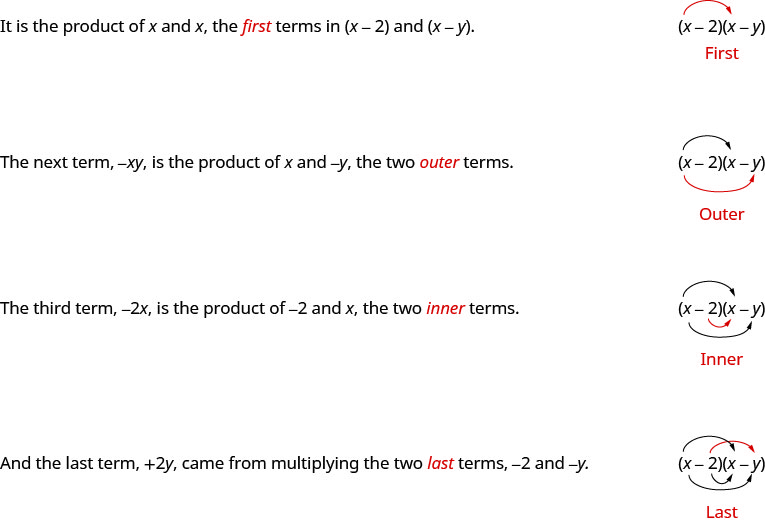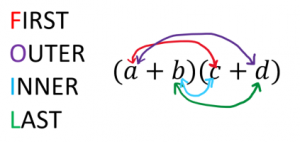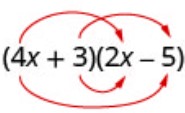6.2 Multiply Polynomials
Learning Objectives
By the end of this section, you will be able to:
- Multiply a polynomial by a monomial
- Multiply a binomial by a binomial
- Multiply a trinomial by a binomial
Multiply a Polynomial by a Monomial
We have used the Distributive Property to simplify expressions like . You multiplied both terms in the parentheses,
and
, by 2, to get
. With this chapter’s new vocabulary, you can say you were multiplying a binomial,
, by a monomial, 2
Multiplying a binomial by a monomial is nothing new for you! Here’s an example:
EXAMPLE 1
Multiply: .
 |
|
| Distribute. | |
| Simplify. |
TRY IT 1.1
Multiply: .
Show answer
TRY IT 1.2
Multiply: .
Show answer
EXAMPLE 2
Multiply: .
 |
|
| Distribute. | |
| Simplify. |
TRY IT 2.1
Multiply: .
Show answer
TRY IT 2.2
Multiply: .
Show answer
EXAMPLE 3
Multiply: .
 |
|
| Distribute. | |
| Simplify. |
TRY IT 3.1
Multiply: .
Show answer
TRY IT 3.2
Multiply: .
Show answer
EXAMPLE 4
Multiply: .
 |
|
| Distribute. | |
| Simplify. |
TRY IT 4.1
Multiply: .
Show answer
TRY IT 4.2
Multiply: .
Show answer
EXAMPLE 5
Multiply: .
 |
|
| Distribute. | |
| Simplify. |
TRY IT 5.1
Multiply: .
Show answer
TRY IT 5.2
Multiply: .
Show answer
EXAMPLE 6
Multiply: .
| The monomial is the second factor. |  |
| Distribute. | |
| Simplify. |
TRY IT 6.1
Multiply: .
Show answer
TRY IT 6.2
Multiply: .
Show answer
Multiply a Binomial by a Binomial
Just like there are different ways to represent multiplication of numbers, there are several methods that can be used to multiply a binomial times a binomial. We will start by using the Distributive Property.
Multiply a Binomial by a Binomial Using the Distributive Property
Look at the table below, where we multiplied a binomial by a monomial.
 |
|
| We distributed the p to get: |  |
| What if we have (x + 7) instead of p? |  |
| Distribute (x + 7). |  |
| Distribute again. |  |
| Combine like terms. |  |
Notice that before combining like terms, you had four terms. You multiplied the two terms of the first binomial by the two terms of the second binomial—four multiplications.
EXAMPLE 7
Multiply: .
 |
|
| Distribute (y + 8). | |
| Distribute again | |
| Combine like terms. |
TRY IT 7.1
Multiply: .
Show answer
TRY IT 7.2
Multiply: .
Show answer
EXAMPLE 8
Multiply: .
 |
|
| Distribute (3y + 4). | |
| Distribute again | |
| Combine like terms. |
TRY IT 8.1
Multiply: .
Show answer
TRY IT 8.2
Multiply: .
Show answer
EXAMPLE 9
Multiply: .
 |
|
| Distribute. | |
| Distribute again. | |
| Combine like terms. |
TRY IT 9.1
Multiply: .
Show answer
TRY IT 9.2
Multiply: .
Show answer
EXAMPLE 10
Multiply: .
 |
|
| Distribute. | |
| Distribute again. | |
| There are no like terms to combine. |
TRY IT 10.1
Multiply: .
Show answer
TRY IT 10.2
Multiply: .
Show answer
Multiply a Binomial by a Binomial Using the FOIL Method
Remember that when you multiply a binomial by a binomial you get four terms. Sometimes you can combine like terms to get a trinomial, but sometimes, like in the above example, there are no like terms to combine.
Let’s look at the last example again and pay particular attention to how we got the four terms.
Where did the first term, , come from?

We abbreviate “First, Outer, Inner, Last” as FOIL. The letters stand for ‘First, Outer, Inner, Last’. The word FOIL is easy to remember and ensures we find all four products.

Let’s look at .
| Distibutive Property | FOIL |
 |
 |
 |
|
 |
 |
 |
 |
Notice how the terms in third line fit the FOIL pattern.
Now we will do an example where we use the FOIL pattern to multiply two binomials.
EXAMPLE 11
TRY IT 11.1
Multiply using the FOIL method: .
Show answer
TRY IT 11.2
Multiply using the FOIL method: .
Show answer
We summarize the steps of the FOIL method below. The FOIL method only applies to multiplying binomials, not other polynomials!
HOW TO: Multiply two binomials using the FOIL method

When you multiply by the FOIL method, drawing the lines will help your brain focus on the pattern and make it easier to apply.
EXAMPLE 12
TRY IT 12.1
Multiply: .
Show answer
TRY IT 12.2
Multiply: .
Show answer
The final products in the last four examples were trinomials because we could combine the two middle terms. This is not always the case.
EXAMPLE 14
Multiply: .
 |
|
| Multiply the First. | |
| Multiply the Outer. | |
| Multiply the Inner. | |
| Multiply the Last. | |
| Combine like terms—there are none. |
TRY IT 14.1
Multiply: .
Show answer
TRY IT 14.2
Multiply: .
Show answer
Be careful of the exponents in the next example.
EXAMPLE 15
Multiply: .
 |
|
| Multiply the First. | |
| Multiply the Outer. | |
| Multiply the Inner. | |
| Multiply the Last. | |
| Combine like terms—there are none. |
TRY IT 15.1
Multiply: .
Show answer
TRY IT 15.2
Multiply: .
Show answer
EXAMPLE 16
Multiply: .
 |
|
| Multiply the First. |
|
| Multiply the Outer. | |
| Multiply the Inner. | |
| Multiply the Last. | |
| Combine like terms. |
TRY IT 16.1
Multiply: .
Show answer
TRY IT 16.2
Multiply: .
Show answer
Multiply a Binomial by a Binomial Using the Vertical Method
The FOIL method is usually the quickest method for multiplying two binomials, but it only works for binomials. You can use the Distributive Property to find the product of any two polynomials. Another method that works for all polynomials is the Vertical Method. It is very much like the method you use to multiply whole numbers. Look carefully at this example of multiplying two-digit numbers.

Now we’ll apply this same method to multiply two binomials.
EXAMPLE 17
Multiply using the Vertical Method: .
Solution
It does not matter which binomial goes on the top.
| Setup for Vertical multiplication | ||
| Multiply Multiple |
Partial Product Partial Product |
|
| Add like terms. | Product |
If you use the FOIL method to multiply these binomials you will notice that the partial products are the same as the terms in the FOIL method.
TRY IT 17.1
Multiply using the Vertical Method: .
Show answer
TRY IT 17.2
Multiply using the Vertical Method: .
Show answer
We have now used three methods for multiplying binomials. Be sure to practice each method, and try to decide which one you prefer. The methods are listed here all together, to help you remember them.
HOW TO: Multiplying Two Binomials
To multiply binomials, use the:
-
- Distributive Property
- FOIL Method
- Vertical Method
Remember, FOIL only works when multiplying two binomials.
Multiply a Trinomial by a Binomial
We have multiplied monomials by monomials, monomials by polynomials, and binomials by binomials. Now we’re ready to multiply a trinomial by a binomial. Remember, FOIL will not work in this case, but we can use either the Distributive Property or the Vertical Method. We first look at an example using the Distributive Property.
EXAMPLE 18
Multiply using the Distributive Property: .
 |
|
| Distribute. |  |
| Multiply. | |
| Combine like terms. |
TRY IT 18.1
Multiply using the Distributive Property: .
Show answer
TRY IT 18.2
Multiply using the Distributive Property: .
Show answer
Now let’s do this same multiplication using the Vertical Method.
EXAMPLE 19
Multiply using the Vertical Method: .
It is easier to put the polynomial with fewer terms on the bottom because we get fewer partial products this way.
| Rewrite the question in vertical setup | |
| Multiply (2b2 − 5b + 8) by Multiply (2b2 − 5b + 8) by |
|
| Add like terms. | |
| There are no more like terms that can be collected. |
TRY IT 19.1
Multiply using the Vertical Method: .
Show answer
TRY IT 19.2
Multiply using the Vertical Method: .
Show answer
We have now seen two methods you can use to multiply a trinomial by a binomial. After you practice each method, you’ll probably find you prefer one way over the other. We list both methods are listed here, for easy reference.
HOW TO: Multiply a Trinomial by a Binomial
To multiply a trinomial by a binomial, use the:
- Distributive Property
- Vertical Method
Access these online resources for additional instruction and practice with multiplying polynomials:
Key Concepts
- FOIL Method for Multiplying Two Binomials—To multiply two binomials:
- Multiply the First terms.
- Multiply the Outer terms.
- Multiply the Inner terms.
- Multiply the Last terms.
- Multiplying Two Binomials—To multiply binomials, use the:
- Multiplying a Trinomial by a Binomial—To multiply a trinomial by a binomial, use the:
- Distributive Property ((Figure))
Practice Makes Perfect
Multiply a Polynomial by a Monomial
In the following exercises, multiply.
| 1. |
2. |
| 3. |
4. |
| 5. |
6. |
| 7. |
8. |
| 9. |
10. |
| 11. |
12. |
| 13. |
14. |
| 15. |
16. |
| 17. |
18. |
| 19. |
20. |
| 21. |
22. |
| 23. |
24. |
| 25. |
26. |
| 27. |
28. |
| 29. |
30. |
| 31. |
32. |
| 33. |
34. |
| 35. |
36. |
| 37. |
38. |
| 39. |
40. |
| 41. |
42. |
| 43. |
44. |
| 45. |
46. |
| 47. |
48. |
| 49. |
50. |
| 51. |
52. |
| 53. |
54. |
| 55. |
56. |
| 57. |
58. |
| 59. |
60. |
| 61. |
62. |
| 63. |
64. |
Multiply a Binomial by a Binomial
In the following exercises, multiply the following binomials using: a) the Distributive Property b) the FOIL method c) the Vertical Method.
| 65. |
66. |
| 67. |
68. |
In the following exercises, multiply the binomials. Use any method.
| 69. |
70. |
| 71. |
72. |
| 73. |
74. |
| 75. |
76. |
| 77. |
78. |
| 79. |
80. |
| 81. |
82. |
| 83. |
84. |
| 85. |
86. |
| 87. |
88. |
| 89. |
90. |
| 91. |
92. |
| 93. |
94. |
Multiply a Trinomial by a Binomial
In the following exercises, multiply using a) the Distributive Property b) the Vertical Method.
| 95. |
96. |
| 97. |
98. |
In the following exercises, multiply. Use either method.
| 99. |
100. |
| 101. |
102. |
Mixed Practice
| 103. |
104. |
| 105. |
106. |
| 107. |
108. |
| 109. |
110. |
| 111. |
112. |
| 113. |
114. |
| 115. |
116. |
| 117. |
118. |
| 119. |
120. |
| 121. |
Everyday Math
|
122. Mental math You can use binomial multiplication to multiply numbers without a calculator. Say you need to multiply 13 times 15. Think of 13 as
|
123. Mental math You can use binomial multiplication to multiply numbers without a calculator. Say you need to multiply 18 times 17. Think of 18 as
|
Writing Exercises
| 124. Which method do you prefer to use when multiplying two binomials: the Distributive Property, the FOIL method, or the Vertical Method? Why? | 125. Which method do you prefer to use when multiplying a trinomial by a binomial: the Distributive Property or the Vertical Method? Why? |
|
126. Multiply the following: Explain the pattern that you see in your answers. |
127. Multiply the following: Explain the pattern that you see in your answers. |
|
128. Multiply the following: Explain the pattern that you see in your answers. |
129. Multiply the following: Explain the pattern that you see in your answers. |
Answers
| 1. |
3. |
| 5. |
7. |
| 9. |
11. |
| 13. |
15. |
| 17. |
19. |
| 21. |
23. |
| 25. |
27. |
| 29. |
31. |
| 33. |
35. |
| 37. |
39. |
| 41. |
43. |
| 45. |
47. |
| 49. |
51. |
| 53. |
55. |
| 57. |
59. |
| 61. |
63. |
| 65. |
67. |
| 69. |
71. |
| 73. |
75. |
| 77. |
79. |
| 81. |
83. |
| 85. |
87. |
| 89. |
91. |
| 93. |
95. |
| 97. |
99. |
| 101. |
103. |
| 105. |
107. |
| 109. |
111. |
| 113. |
115. |
| 117. |
119. |
| 121. |
123. a) 306 b) 306 c) Answers will vary. |
| 125. Answers will vary. | 127. Answers will vary. |
| 129. Answers will vary. |
Attributions
This chapter has been adapted from “Multiply Polynomials” in Prealgebra (OpenStax) by Lynn Marecek, MaryAnne Anthony-Smith, and Andrea Honeycutt Mathis, which is under a CC BY 4.0 Licence. Adapted by Izabela Mazur. See the Copyright page for more information.






